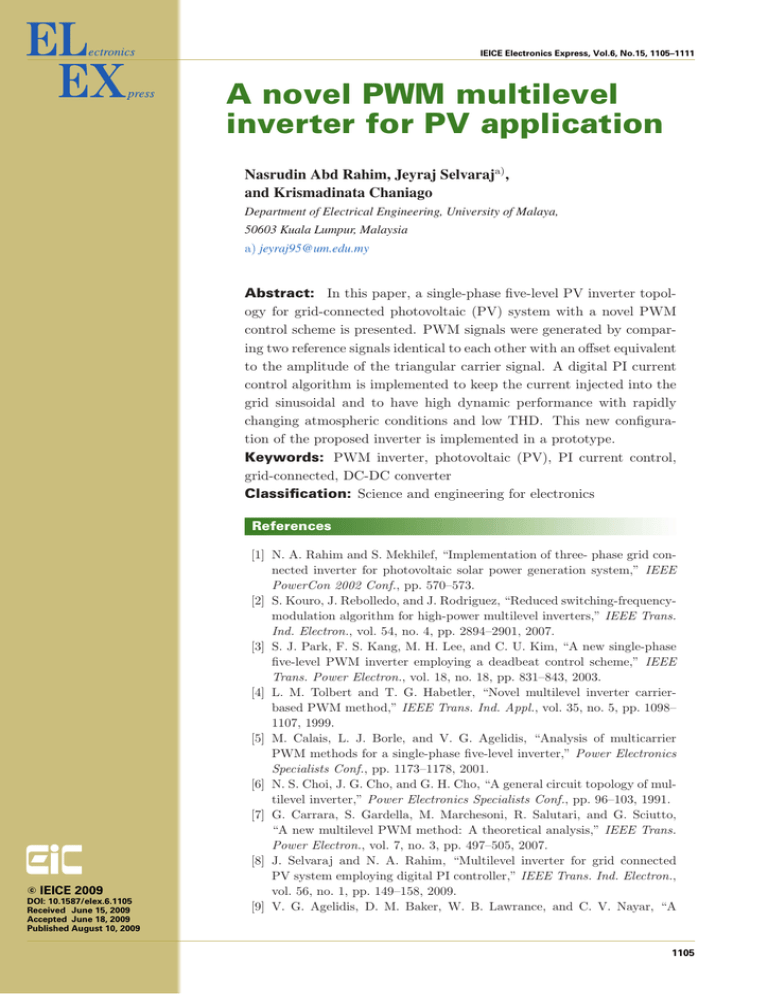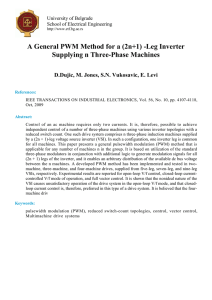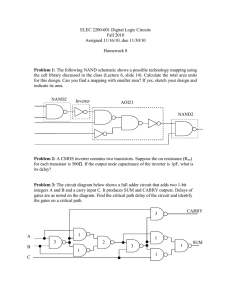
IEICE Electronics Express, Vol.6, No.15, 1105–1111
A novel PWM multilevel
inverter for PV application
Nasrudin Abd Rahim, Jeyraj Selvaraja) ,
and Krismadinata Chaniago
Department of Electrical Engineering, University of Malaya,
50603 Kuala Lumpur, Malaysia
a) jeyraj95@um.edu.my
Abstract: In this paper, a single-phase five-level PV inverter topology for grid-connected photovoltaic (PV) system with a novel PWM
control scheme is presented. PWM signals were generated by comparing two reference signals identical to each other with an offset equivalent
to the amplitude of the triangular carrier signal. A digital PI current
control algorithm is implemented to keep the current injected into the
grid sinusoidal and to have high dynamic performance with rapidly
changing atmospheric conditions and low THD. This new configuration of the proposed inverter is implemented in a prototype.
Keywords: PWM inverter, photovoltaic (PV), PI current control,
grid-connected, DC-DC converter
Classification: Science and engineering for electronics
References
c
IEICE 2009
DOI: 10.1587/elex.6.1105
Received June 15, 2009
Accepted June 18, 2009
Published August 10, 2009
[1] N. A. Rahim and S. Mekhilef, “Implementation of three- phase grid connected inverter for photovoltaic solar power generation system,” IEEE
PowerCon 2002 Conf., pp. 570–573.
[2] S. Kouro, J. Rebolledo, and J. Rodriguez, “Reduced switching-frequencymodulation algorithm for high-power multilevel inverters,” IEEE Trans.
Ind. Electron., vol. 54, no. 4, pp. 2894–2901, 2007.
[3] S. J. Park, F. S. Kang, M. H. Lee, and C. U. Kim, “A new single-phase
five-level PWM inverter employing a deadbeat control scheme,” IEEE
Trans. Power Electron., vol. 18, no. 18, pp. 831–843, 2003.
[4] L. M. Tolbert and T. G. Habetler, “Novel multilevel inverter carrierbased PWM method,” IEEE Trans. Ind. Appl., vol. 35, no. 5, pp. 1098–
1107, 1999.
[5] M. Calais, L. J. Borle, and V. G. Agelidis, “Analysis of multicarrier
PWM methods for a single-phase five-level inverter,” Power Electronics
Specialists Conf., pp. 1173–1178, 2001.
[6] N. S. Choi, J. G. Cho, and G. H. Cho, “A general circuit topology of multilevel inverter,” Power Electronics Specialists Conf., pp. 96–103, 1991.
[7] G. Carrara, S. Gardella, M. Marchesoni, R. Salutari, and G. Sciutto,
“A new multilevel PWM method: A theoretical analysis,” IEEE Trans.
Power Electron., vol. 7, no. 3, pp. 497–505, 2007.
[8] J. Selvaraj and N. A. Rahim, “Multilevel inverter for grid connected
PV system employing digital PI controller,” IEEE Trans. Ind. Electron.,
vol. 56, no. 1, pp. 149–158, 2009.
[9] V. G. Agelidis, D. M. Baker, W. B. Lawrance, and C. V. Nayar, “A
1105
IEICE Electronics Express, Vol.6, No.15, 1105–1111
[10]
[11]
[12]
[13]
1
multilevel PWM inverter topology for photovoltaic application,” Proc.
IEEE ISIE’97, pp. 589–594, 1997.
M. H. Rashid, “Power electronics: Circuits, Devices, and Applications,
third ed.,” Pearson Prentice Hall, New Jersey, p. 267, 2004.
T. Esram and P. L. Chapman, “Comparison of photovoltaic array maximum power point tracking techniques,” IEEE Trans. Energy Convers.,
vol. 22, no. 2, pp. 2894–2901, 2007.
N. Femia, G. Petrone, G. Spagnuolo, and M. Vitelli, “Optimizing dutycycle perturbation of P&O MPPT technique,” Power Electronics Specialists Conf., pp. 1939–1944, 2004.
X. Liu and L. A. C. Lopes, “An improved perturbation and observation maximum power point tracking algorithm for PV arrays,” Power
Electronics Specialists Conf., pp. 2005–2010, 2004.
Introduction
Much of the world’s energy needs can be supplied directly by solar power [1].
Solar power technologies can be divided into two groups; one uses the sun to
generate heat and is called solar thermal technologies, and the other converts
the sun’s radiation directly into electricity through photoelectric effect. Solar
thermal technologies include solar concentrator power systems, flat plate solar
collectors, and passive solar heating. Photoelectric effect uses solar cells
called photovoltaic (PV).
This paper presents a single-phase five-level inverter with a transformer
for grid-connected application. A five-level configuration is used because
it offers great advantages such as improved output waveforms, smaller filter
size, lower EMI and lower THD compared with conventional three-level PWM
inverter [2, 3, 4, 5, 6, 7] To generate output voltage in five-levels, full-bridge
inverter configuration together with an auxiliary circuit as shown in Fig. 1
was used.
2
c
IEICE 2009
DOI: 10.1587/elex.6.1105
Received June 15, 2009
Accepted June 18, 2009
Published August 10, 2009
Five-Level inverter topology
The proposed single-phase five-level inverter topology consists of a dc-dc
boost converter connected to two capacitors in series, an auxiliary circuit,
a full-bridge inverter, a step-up transformer and utility grid. In this paper,
the inverter is designed to work as a grid-connected system; therefore utility
grid is used instead of load. The dc-dc boost converters are used to track
the maximum power point (MPP) of the solar arrays as well as to step-up
√
the peak inverter output voltage, Vinv to be more than 2 of the rms grid
voltage, Vg to ensure power flow from the PV arrays into the grid. As a
step-up transformer with a ratio of 1 : 2 is used, Vinv should be:
√
2Vg
Vinv >
or
(1)
2
Vg
Vinv > √
(2)
2
1106
IEICE Electronics Express, Vol.6, No.15, 1105–1111
Fig. 1. Five-level inverter with control algorithm implemented in DSP TMS320F2812.
A filtering inductance Lf is used to filter the current injected into the grid.
The injected current must be sinusoidal with low harmonic distortion [8].
3
PWM modulation and operational principle
The proposed PWM modulation strategy is shown in Fig. 2. Two reference
signals Vref 1 and Vref 2 and a triangular carrier signal Vcarrier were used to
c
IEICE 2009
DOI: 10.1587/elex.6.1105
Received June 15, 2009
Accepted June 18, 2009
Published August 10, 2009
Fig. 2. Switching pattern for single-phase five-level inverter.
1107
IEICE Electronics Express, Vol.6, No.15, 1105–1111
generate the PWM switching signals. Modulation index Ma for five-level
PWM inverter is described as [9]
Ma =
Am
2Ac
(3)
where Ac is the amplitude of carrier signal and Am is the amplitude of voltage reference Vref . If Ma > 1, higher harmonics in the phase waveform is
obtained. Therefore, Ma is maintained between 0 and 1. If the amplitude
of the reference signal is increased higher than the amplitude of the carrier
signal, i.e. Ma > 1, this will lead to overmodulation. Large values of Ma in
sinusoidal PWM techniques lead to full overmodulation [10]. From the PWM
modulation, the analysis of harmonic components in the proposed inverter
can be preformed. The output voltage produced by comparison of the two
reference signals and the carrier signal can be expressed as [3]
Vo (θ) = A0 +
∞
(An cos nθ + Bn sin nθ)
(4)
n=1
If there are P pulses per quarter period, and it is an odd number, the coefficients Bn and Ao would be a zero where n is an even number. Therefore,
the Eq. (4) can be rewritten as
Vo (θ) =
∞
An cos nθ
(5)
n=1,3...
An = −
4 P 2VP V (−1)int(i/2) sin(nαm+i )
nπ m=0 i=1
(6)
where m is a pulse number α is the phase angle displacement. The Fourier
series coefficients of the conventional single-phase full-bridge inverter by sinusoidal PWM is given as
P
4VP V [(−1)m sin(nαm )]
An =
nπ m=1
c
IEICE 2009
DOI: 10.1587/elex.6.1105
Received June 15, 2009
Accepted June 18, 2009
Published August 10, 2009
(7)
The main objective of designing a grid-connected PV inverter is to inject sinusoidal current into the utility grid. In order to generate sinusoidal current
with low harmonic distortion, a sinusoidal PWM is used since it is one of
the most effective methods. Sinusoidal PWM is obtained by comparing a
high-frequency carrier with a low-frequency sinusoid, which is the modulating signal or reference signal. The carrier has a constant period; therefore
the switches have constant switching frequency. The switching instant is
determined from the crossing of the carrier and the modulating signal.
In this work, dual reference modulation technique is incorporated into the
sinusoidal PWM technique to produce PWM switching signals for the fullbridge inverter switches and auxiliary switch. Two reference signals Vref 1
and Vref 2 will take turns to be compared with the carrier signal at a time. If
Vref 1 exceeds the peak amplitude of the carrier signal Vcarrier , Vref 2 will be
compared with the carrier signal until it reaches 0. At this point onwards,
1108
IEICE Electronics Express, Vol.6, No.15, 1105–1111
Vref 1 takes over the comparison process until it exceeds Vcarrier . This will lead
to a switching pattern as shown in Fig. 2. Switches S2 –S4 will be switching
at the rate of the carrier signal frequency while S5 and S6 will operate at a
frequency equivalent to the fundamental frequency.
4
Control system algorithm and implementation
The proposed inverter is used in a grid-connected PV system. Therefore, a
PI current control scheme is employed to keep the output current sinusoidal
and to have high dynamic performance under rapidly changing atmospheric
conditions and to maintain the power factor at near unity. As the irradiance level is inconsistent throughout the day, the amount of electric power
generated by the solar modules is always changing with weather conditions.
To overcome this problem, Maximum Power Point Tracking (MPPT) algorithm is used. It tracks the operating point of the I–V curve to its maximum
value. Therefore, the MPPT algorithm will ensure maximum power is delivered from the solar modules at any particular weather conditions. Various
MPPT control algorithm have been discussed in detail by [11, 12, 13].
In this proposed inverter, Perturb and Observe (P&O) algorithm is used
to extract maximum power from the PV modules. Refering to Fig. 1, the
feedback PI current control senses the current injected into the grid also
known as grid current Ig and feed back to a comparator which compares it
with reference current Iref . Iref is obtained by sensing the grid voltage and
converting it to reference current and multiplying it with variable m. m is
a variable that is used as the multiplication factor for Vg to generate Iref .
Therefore,
(8)
Iref = mVg
The five-level inverter with the control algorithm implemented in DSP
TMS320F2812 is shown in Fig. 1. Since variable m is dependent on the
MPPT algorithm, as the irradiance level increases, variable m also increases.
Therefore it can be concluded that,
m ∝ irradiance of the sun
The instantaneous current error from the comparison between Iref and Ig is
fed to a PI controller. The integral term in the PI controller improves the
tracking by reducing the instantaneous error between the reference and the
actual current. The resulting error signal u which forms the dual reference
signals Vref 1 and Vref 2 is compared with a triangular carrier signal and intersections are sought to produce PWM signals for the inverter switches. This
is to ensure Ig to be in phase with grid voltage Vg and always at near unity
power factor.
5
c
IEICE 2009
DOI: 10.1587/elex.6.1105
Received June 15, 2009
Accepted June 18, 2009
Published August 10, 2009
Experimental results
The proposed inverter is tested by using DSP TMS320F2812. 12 SIEMENS
SP75 panels were connected in series and parallel configuration to produce
1109
IEICE Electronics Express, Vol.6, No.15, 1105–1111
900 W of peak power. The switching frequency is set at 20 kHz while Dc bus
capacitors, C1 and C2 is set at 2200 uF. L1 is 2.2 mH and Lf is 3 mH. Transformer ratio of 1 : 2 is used to step Vinv . Fig. 3 (a) illustrates the experimental
√
results for Vinv and Ig for conditions Vc > Vg / 2 and Ma < 1.0. The result
illustrates that Vinv consists of five levels of output voltage and Ig has been
filtered to resemble a pure sinewave. Fig. 3 (b) shows Vinv and Ig for threelevel inverter. Vinv consist of three level of output voltage. To prove that the
proposed five-level inverter has advantages over the conventional three-level
inverter in terms of THD and power factor, the corresponding measurements
were made on both inverters. FLUKE 43B Power Quality Analyzer was used
for this purpose. The THD measurement for the proposed five-level inverter
is shown in Fig. 3 (c). The THD for the proposed inverter is 7.5%. The results from five-level PWM inverter are compared with those from three-level
PWM inverter in terms of THD. The only difference between the five-level
inverter and three-level inverter is the elimination of auxiliary circuit and
therefore only one dc bus capacitor is used. The same current control techniques were used to control the overall performance of the inverter. As shown
in Fig. 3 (d), the THD measurement of the three-level inverter is 12.8%. The
result was taken at almost the same environmental conditions to ensure Ig to
be similar to measurement made for the five-level inverter. By comparison,
the THD measurement for three-level inverter is much higher when compared
with for five-level inverter. More levels of output voltage will reduce the THD
c
IEICE 2009
DOI: 10.1587/elex.6.1105
Received June 15, 2009
Accepted June 18, 2009
Published August 10, 2009
Fig. 3. (a) Experiment results of Vinv and Ig , for fivelevel inverter (b) Experiment Results of Vinv and
Ig for three-level inverter (c) THD result of fivelevel PV inverter., (d) THD result of three-level
PV inverter.
1110
IEICE Electronics Express, Vol.6, No.15, 1105–1111
of the grid current. This proves that multilevel inverters can reduce the THD
which is an essential criterion for grid-connected PV systems.
6
Conclusion
This paper presented a single-phase five-level inverter with a dual reference
modulation technique for PV application. The dual reference modulation
technique involves comparing two reference signals identical to each other
except for an offset equivalent to its carrier signal, with a triangular carrier
signal to generate PWM switching signals for the switches. The circuit topology, control algorithm and operational principle of the proposed inverter were
analyzed in detail. A digital PI current control algorithm is implemented in
DSP TMS320F2812 to optimize the performance of the inverter. Comparison has been made between the five-level and three-level inverter in term of
THD. The results show that the THD of the five-level inverter is much less
than that of the conventional three-level inverter.
c
IEICE 2009
DOI: 10.1587/elex.6.1105
Received June 15, 2009
Accepted June 18, 2009
Published August 10, 2009
1111





